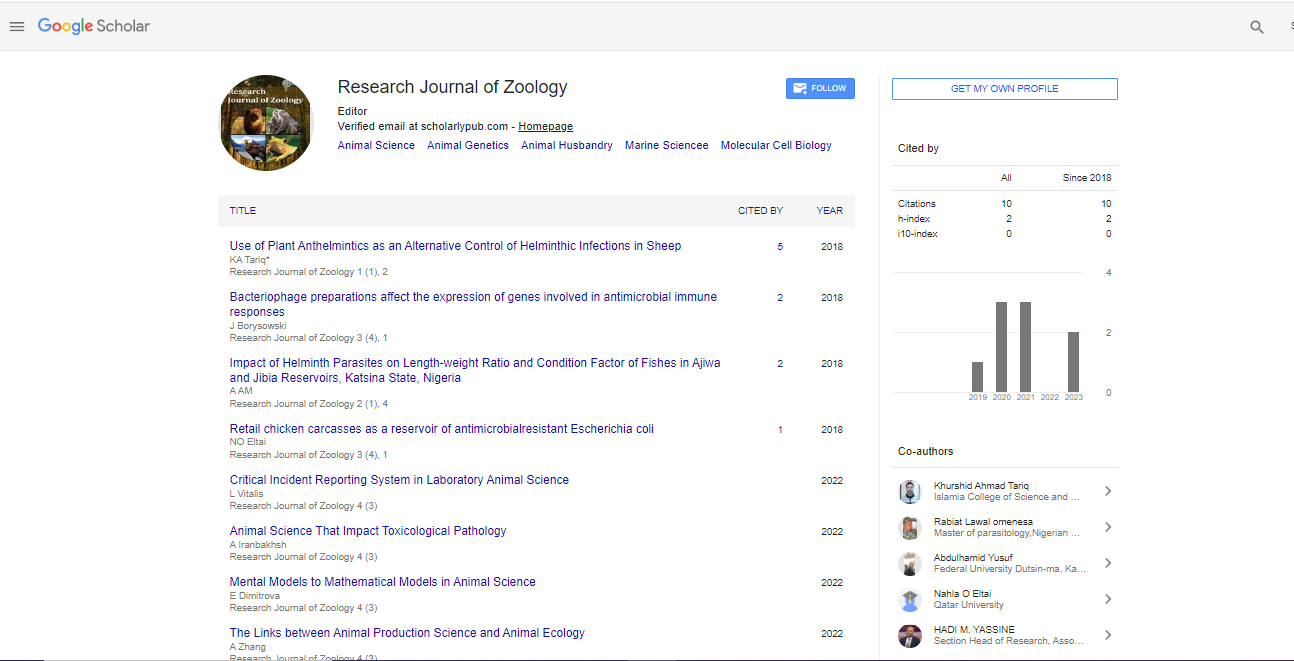Opinion Article, Res J Zool Vol: 5 Issue: 2
Cladistics in Zoology: Deciphering Evolutionary Relationships and Biodiversity
Fabien Carmeliet*
1Department of Zoology, University of Lausanne, Lausanne, Switzerland
*Corresponding Author: Fabien Carmeliet,
Department of Zoology, University of
Lausanne, Lausanne, Switzerland
E-mail: carmelietfabien@gmail.com
Received date: 29 May, 2023, Manuscript No. RJZ-23-107014;
Editor assigned date: 31 May, 2023, PreQC No. RJZ-23-107014 (PQ);
Reviewed date: 14 June, 2023, QC No. RJZ-23-107014;
Revised date: 21 June, 2023, Manuscript No. RJZ-23-107014 (R);
Published date: 28 June, 2023, DOI: 10.4172/Rjz.1000085.
Citation: Carmeliet F (2023) Cladistics in Zoology: Deciphering Evolutionary Relationships and Biodiversity. Res J Zool 5:2.
Description
In zoology, cladistics is a vital methodological approach used to study and understand the evolutionary relationships among different animal species. By analyzing shared characteristics and applying principles of parsimony, cladistics helps zoologists construct phylogenetic trees that depict the evolutionary history and relatedness of organisms. This systematic approach is instrumental in deciphering the complex web of life and biodiversity, providing essential insights into the processes of speciation, adaptation, and the diversification of animal life on Earth.
Importance of cladistics in zoology
Cladistics has revolutionized the field of zoology by providing a more objective and evidence-based way to study animal relationships. Prior to cladistics, classification systems were based on superficial resemblances, leading to inaccuracies and inconsistencies. Cladistics, on the other hand, focuses on identifying homologous traits shared among species, allowing for a more accurate and robust understanding of their evolutionary history. This has led to significant advances in zoological research, taxonomy, and conservation efforts.
Monophyletic groups: In cladistics, zoologists aim to identify monophyletic groups or clades, which include a common ancestor and all its descendants. Clades represent true evolutionary lineages and are considered natural groups.
Homologous characteristics: Homologous characteristics are traits shared by species due to common ancestry. These traits may have evolved through time but are connected by their shared evolutionary history.
Analogous characteristics: Analogous characteristics, also known as convergent traits, are features that are similar in function or appearance but have evolved independently in different lineages. Cladistics focuses on homologous characteristics for constructing phylogenetic trees.
Outgroup: In cladistic analysis, an out group is a species that is closely related to the group under study but branched off earlier in evolutionary history. The outgroup helps to root the phylogenetic tree and determine the direction of evolutionary change.
Character selection: Zoologists select morphological, molecular, or behavioral characteristics that are relevant to the group of animals under investigation. These traits should be present in all species being studied and exhibit enough variation to distinguish between groups.
Character state determination: For each selected characteristic, researchers determine the presence or absence of a particular character state in each species. This information is recorded in a matrix format. The matrix is a data table that represents the presence or absence of character states for each species. It serves as the basis for constructing the cladogram.
Cladogram construction: Using specialized software or manual analysis, zoologists apply the principle of parsimony to produce a cladogram that minimizes the number of evolutionary changes required to explain the distribution of shared characteristics among species.
Applications
Taxonomy and classification: Cladistics has revolutionized the classification of animals by providing a more accurate and objective framework for arranging species based on their evolutionary relationships.
Phylogenetic studies: Cladistic analyses help zoologists unravel the evolutionary history and relatedness of various animal groups, shedding light on their origins and diversification.
Conservation efforts: Understanding the evolutionary relationships among species aids in prioritizing conservation efforts, identifying species that are particularly important for preserving biodiversity.
Biogeography: Cladistics contributes to the study of historical biogeography by uncovering the movement and distribution of animals across different geographical regions over time.
Conclusion
Cladistics is a powerful tool in zoology that allows researchers to uncover the intricate evolutionary relationships among animal species. By focusing on shared characteristics and applying principles of parsimony, cladistics provides a more objective and evidence-based understanding of the evolutionary history and biodiversity in the animal kingdom. This approach continues to play a vital role in advancing zoological research and contributes significantly to our knowledge of the natural world.
 Spanish
Spanish  Chinese
Chinese  Russian
Russian  German
German  French
French  Japanese
Japanese  Portuguese
Portuguese  Hindi
Hindi 
